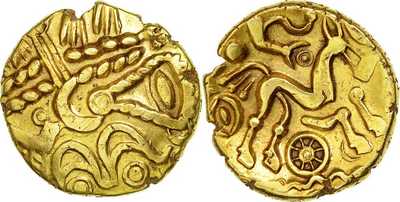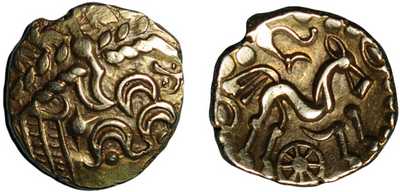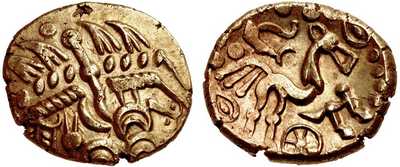| Back to Gallo Belgic E | This page is part of the article Getting Started with Celtic Coins | Forward to Eye Staters |
Gallo-Belgic F is important to collectors of British Celtic coins, because it was the prototype coin for the British Qa coins, and these were the starting point for the gold coinage that dominated the south of Britain after Caesar.
Despite being a very widely held belief, it appears that it’s not actually true. Instead, it seems that British Qa was derived from a little known coin called Gallo-Belgic G. We’ll take a quick look at both coins here.
Gallo-Belgic F
Gallo-Belgic F was minted by the Suessiones at some point shortly after the start of Gallo-Belgic E. It is stylistically derived from the Gallo-Belgic C coins, but features an additional “Eye” on the obverse that comes from a coin of the Remi (we’ll look at that soon, but for reference, it’s Scheers 30 class 1). Gallo-Belgic F is also known as one of the “Eye Stater” or “à l’oeil” types.
Copyright Comptoir des Monnaies
Gallo-Belgic G
Gallo-Belgic G was minted by the Catuslougi who are thought to have been under the control of the Suessiones. The design is remarkably similar to Gallo-Belgic F; the main difference being an “anchor” on the obverse in place of the “eye”. Because of this, it’s more commonly known as the “Ã l’ancre” type.
The reverses are almost identical, and at least one Gallo-Belgic F reverse die was paired with a Gallo-Belgic G obverse.
Gallo-Belgic G was a smaller issue than Gallo-Belgic F. They were struck in parallel, but Gallo-Belgic G seems to have stopped long before Gallo-Belgic F did.
Similarities to British Qa
The reverses of the three types are almost identical. However, the obverses of Gallo-Belgic F and British Qa are different, with British Qa missing the “eye” feature. On the other hand, the obverses of British Qa and Gallo-Belgic G are almost identical. In fact, they are so similar in the first British Qa class that it is thought that they were engraved by the same person. British Qa class 2 gains two small bars between the wreath and one of the crescents which helps with identification.
Copyright Comptoir des Monnaies
Copyright Classical Numismatic Group, LLC
Further Reading
- “Divided Kingdoms: The Iron Age Gold Coinage of Southern England” by Dr. John Sills
Article Navigation
| Back to Gallo Belgic E | Up to Third Generation Coins (c. 125 BC to c. 50 BC) | Forward to Eye Staters |



